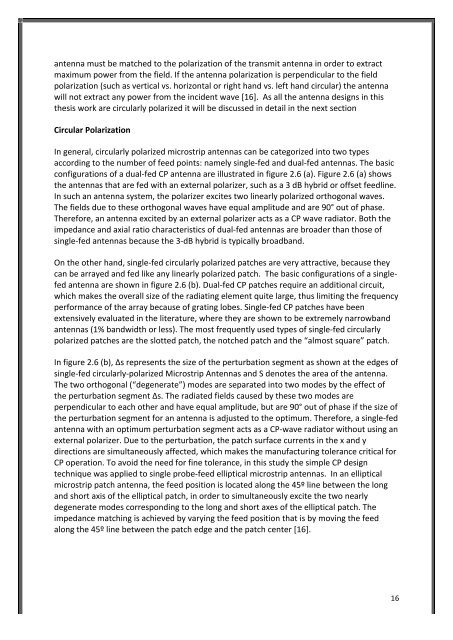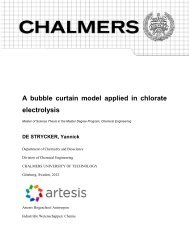Master Thesis
Master Thesis
Master Thesis
You also want an ePaper? Increase the reach of your titles
YUMPU automatically turns print PDFs into web optimized ePapers that Google loves.
antenna must be matched to the polarization of the transmit antenna in order to extract<br />
maximum power from the field. If the antenna polarization is perpendicular to the field<br />
polarization (such as vertical vs. horizontal or right hand vs. left hand circular) the antenna<br />
will not extract any power from the incident wave [16]. As all the antenna designs in this<br />
thesis work are circularly polarized it will be discussed in detail in the next section<br />
Circular Polarization<br />
In general, circularly polarized microstrip antennas can be categorized into two types<br />
according to the number of feed points: namely single-‐fed and dual-‐fed antennas. The basic<br />
configurations of a dual-‐fed CP antenna are illustrated in figure 2.6 (a). Figure 2.6 (a) shows<br />
the antennas that are fed with an external polarizer, such as a 3 dB hybrid or offset feedline.<br />
In such an antenna system, the polarizer excites two linearly polarized orthogonal waves.<br />
The fields due to these orthogonal waves have equal amplitude and are 90° out of phase.<br />
Therefore, an antenna excited by an external polarizer acts as a CP wave radiator. Both the<br />
impedance and axial ratio characteristics of dual-‐fed antennas are broader than those of<br />
single-‐fed antennas because the 3-‐dB hybrid is typically broadband.<br />
On the other hand, single-‐fed circularly polarized patches are very attractive, because they<br />
can be arrayed and fed like any linearly polarized patch. The basic configurations of a single-‐<br />
fed antenna are shown in figure 2.6 (b). Dual-‐fed CP patches require an additional circuit,<br />
which makes the overall size of the radiating element quite large, thus limiting the frequency<br />
performance of the array because of grating lobes. Single-‐fed CP patches have been<br />
extensively evaluated in the literature, where they are shown to be extremely narrowband<br />
antennas (1% bandwidth or less). The most frequently used types of single-‐fed circularly<br />
polarized patches are the slotted patch, the notched patch and the “almost square” patch.<br />
In figure 2.6 (b), ∆s represents the size of the perturbation segment as shown at the edges of<br />
single-‐fed circularly-‐polarized Microstrip Antennas and S denotes the area of the antenna.<br />
The two orthogonal (“degenerate”) modes are separated into two modes by the effect of<br />
the perturbation segment ∆s. The radiated fields caused by these two modes are<br />
perpendicular to each other and have equal amplitude, but are 90° out of phase if the size of<br />
the perturbation segment for an antenna is adjusted to the optimum. Therefore, a single-‐fed<br />
antenna with an optimum perturbation segment acts as a CP-‐wave radiator without using an<br />
external polarizer. Due to the perturbation, the patch surface currents in the x and y<br />
directions are simultaneously affected, which makes the manufacturing tolerance critical for<br />
CP operation. To avoid the need for fine tolerance, in this study the simple CP design<br />
technique was applied to single probe-‐feed elliptical microstrip antennas. In an elliptical<br />
microstrip patch antenna, the feed position is located along the 45º line between the long<br />
and short axis of the elliptical patch, in order to simultaneously excite the two nearly<br />
degenerate modes corresponding to the long and short axes of the elliptical patch. The<br />
impedance matching is achieved by varying the feed position that is by moving the feed<br />
along the 45º line between the patch edge and the patch center [16].<br />
16
















